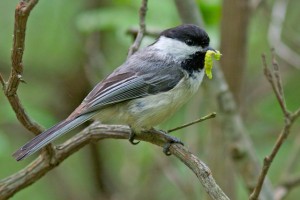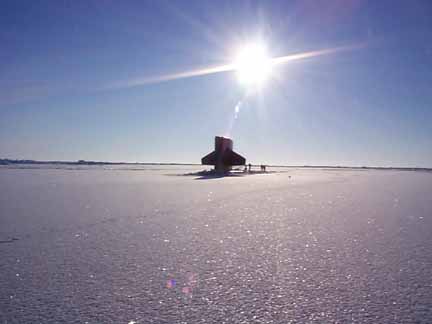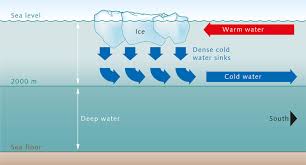The movie ''
An Inconvenient Truth'' was released in 2006 in United States when I was in standard six (who was still unaware of anything about global climate). I first watched the movie during a leadership camp in high school (and I was in half-asleep state due to the tiring schedule) when I was in form three but I barely remembered the informations embedded in the movie, not even its name. Now it's 2014, and I rewatched this very informative and motivating movie with my fellow coursemates during our Chemistry class. I tried to absorb and write down as much facts as possible that was mentioned by
Al Gore throughout the movie but did not pay much attention to the travelling parts.
So before I introduce the movie, let's see who is Al Gore. Most of us (or maybe all of us) had never heard this name. Albert Arnold Gore was actually the 45th Vice President of the United States from 1993 to 2001, under President Bill Clinton. Now he is still an active environmentalist who has contributed a lot for the environment (for more information you guys can utilise Google, haha). In 2007, this movie was awarded an Academy Award for Best Documentary and Al Gore was given the
Nobel Peace Prize with
Intergovernmental Panel on Climate Change (IPCC). There are a lot of criticism on this movie as it was produced by a politician but I am just going to focus on the issue of global warming by breaking information I extracted from the movie into a few parts (plus some of my elaboration):
1) According to the world map, we can see that most of the land on Earth locates on the North Hemisphere. When the North Hemisphere receive more sunlight (which is during Spring or Summer), the plants on land take up the carbon dioxide in the atmosphere for photosynthesis, thus the level of carbon dioxide would be lowered. On the other hand, when it is Autumn or Winter for the North Hemisphere, less sunlight will be received by the plants, so the rate of photosynthesis decreases, leading to a higher carbon dioxide level in the atmosphere. The carbon dioxide concentration in the atmosphere is actually fluctuated, going up and down each year. However, it is getting higher and higher despite the normal up and down trend.
 |
| (Graph taken from ''Climate Change 2013: The Physical Science Basis'' by IPCC) |
2) Glaciers on mountain top are actually our precious fresh water source (even though we do not have glacier in Malaysia). During spring, glaciers on mountains such as Himalaya will melt slowly and contribute to the streams flowing down the mountain. So if the glaciers melt faster than normal, our fresh water source will deplete pretty soon. When the glaciers (which reflect the sunlight) melt, the rocky surface of the mountain will be exposed to direct sunlight, thus absorbing more heat which in turn speeding up the melting process.
 |
| (Google image) |
3) The carbon dioxide concentration in the atmosphere hundreds or thousands of years ago can be measured by analysing the air bubble trapped within the glaciers which formed long long time ago. Scientists drill ice cores to extract information about the atmospheric composition or even temperature from these tiny air bubbles preserved by the glaciers. We can see that the ice core consists of layers of ices, each ice band represents the condition of the snowfall during that season. Sometimes it trapped particles such as volcanic ashes which would tell us more about the climate of those previous years.
.jpg) |
| (Google image) |
4) As we know, temperature is proportional to the carbon dioxide concentration in the atmosphere. In Malaysia this fact is accepted widely by students but I heard that there are some arguments regarding whether global warming is caused by carbon dioxide or not. So here is the evidence of the relationship between carbon dioxide concentration in the atmosphere and the global temperature.
 |
| (Google image) |
5) The increase in ocean temperature contributes to the increase in the evaporation of sea water. Thus, this raises the humidity in the air, speeding up the wind velocity and eventually elevates the intensity of hurricane (for some places we call it typhoon or cyclone). Hurricane takes up its speed as it moves through warm ocean, gaining more and more water vapour and getting bigger and stronger. That's why hurricanes today bring more destruction than ever.
.jpg) |
| Hurricane Katrina (Google image) |
6) Extreme weathers happen everywhere where droughts and floods could happen at the same time at different places. As more sea water evaporates from the ocean, more moisture on land is also being 'sucked' up into the atmosphere, resulting in dry parched land. Precipitation (rainfall) relocates and focuses on a particular area. Higher temperature means higher rate of evaporation, there would be more rainfall which could be very destructive as the amount of rains is too large at one time.
 |
| (Google image) |
7) Permafrost is the layer of ice on the land surface that never melts throughout the year, previously. Now due to the melting of permafrost, there is a phenomenon called the drunken trees where trees having their roots buried deep down in the permafrost are tilted as their roots have nothing to grab on. So the trees lean to one side in an awkward position, indicating the melting of the once-would-never-melt ice.
 |
| (Google image) |
8) As the Earth gets warmer, falls and winters become shorter. So spring arrives earlier than usual causing caterpillars to hatch earlier. However, birds are warm-blooded animals whose biological behavior do not follow the change of environment. By the time the birdlings hatch, most of the caterpillars have turned into pupae that there is no food for the birdlings. This has caused a huge disruption to the ecosystem where the caterpillars will have less predators, destroying plants that they feed on. It is really an ecological disaster.
 |
| (Google image) |
9) The floating ice cap in Artic has become so thin that even a submarine can penetrate and emerge from the ice. Usually submarines cannot penetrate through the ice without damaging their bodies. The thickness of Artic ice even varies up to 1 meter 'thin'.
 |
| (Google image) |
10) Ice acts as reflector of sunlight on Earth. It can reflect as much as 90% of sunlight reaching the glaciers. But when the glaciers melt, less sunlight will be reflected. More than 90% of sunlight will be absorbed by the ocean and even though ocean has a large heat capacity, heat is being stored and piled up slowly in the ocean, causing a rise of temperature.
 |
| (Google image) |
11) Ocean and wind currents are responsible in distributing the heat absorbed by the Earth surface from the equator to the poles as equators receive more sunlight than the poles. Today, as the equator obtains much more heat from the sun, causing the poles to gain more heat from the currents as the heat is brought to the poles. Thus, the poles will be heated up faster than the equators, speeding up the melting of glaciers. The circulation heat works this way: The surface of the ocean which directly receives sunlight becomes warmer. As the current goes northward, sea water evaporates and ice forms and the current becomes colder and denser (saltier as water evaporates and the formation of ice, leaving behind salts in the current) when it reaches north pole. The denser and colder current will sink and moves southward back to the equator which is warmer. The theory of thermodynamics can be applied here where heat comes from warmer area to colder area.
 |
| (Google image) |
12) Assuming that there is a frozen lake near the north pole. As our Earth becomes warmer, ice in the middle of the lake melts until the ice at the border of the lake breaks and the cold water rushes into the sea. This can immediately lower down the temperature of ocean current at the north pole and completely stop the circulation of heat carried by the ocean current. Heat cannot be distributed evenly on Earth and we can imagine the consequences that follow. Of course this is just an assumption as there is no such large frozen lake near the North pole.
 |
| (Google image) |
13) The distribution of species on Earth mainly depends on the climate of the habitats. As climate changes, invasive species begins to infest and thrive at the area where it does not exist previously. Many parasites grow well at warmer temperature. For example, pine beetles which are usually being killed by the cold of winter. But as the period of winter becomes short, pine beetles destroy the pine forest more severely, damaging the habitat of other animals. Another example of invasive species is mosquito. Mosquitoes begin to move to higher altitude as the temperature rises. This causes the re-emerging of diseases such as Dengue fever among our population.
 |
| (Google image) |
14) Sea creatures are really sensitive towards the surrounding temperature where any fluctuation in temperature can easily lead to death. One of the most affected species is the coral reef. Coral reef is the habitats for lots of sea creatures, providing shelters besides reducing the speed of strong ocean current. However, the rise in temperature causing the bleaching effect of the coral reef, leaving behind lifeless and stone-like structures. The loss of habitats and natural ramparts indicate the danger of massive species extinction underwater.
 |
| (Google image) |
15) At the ocean, basically there are two types of ices: sea-based ices and land-based ices. Sea-based ices are ices that float freely on the ocean surface which will not contribute to the raise of sea level when they melt (if you place a ice cube in a glass full of water, after the ice cube melts, the water in the glass will not overflow). On the other hand, for the land-based ices, the melting will cause a rise in sea level, flooding all the low-lying coastal areas.
 |
| (Google image) |
16) In Antartica, a pool of water will be formed in the middle of the ice shelf which slowly penetrates through the thick glaciers (we call the structure 'moulin'), causing the ice shelf which was formed centuries ago to break into half, creating a deep shaft reaching the land surface of the Antartica. As the pool of water which is slightly warmer than the surrounding ice, after it reaches the bottom of the ice shelf, it starts to sip through the bottom of the ice shelf. Eventually the whole large piece of ice shelf which is located seaward would slide and fall into the sea. In this case, we would immediately lose a huge chunk of glacier which contributes to the rise in sea level.
 |
| (Google image) |
These are the facts that I am able to extract from the movie, hoping that those who could not understand or catch up with the pace of the movie (as it has no subtitle) can get some ideas from this post. For those who have not watched this movie after 8 years the movie was produced, watch it! Maybe you can just ignore the political components in the movie if you do not like it, but the facts are precious.
P/S: I might miss out some points in this post. Correct me if I am wrong in any of the information yeah. ;)
(Special thanks to Dr. Kannan for correcting me in some points!)


.jpg)

.jpg)









Wendy: This a fabulous effort! Very impressive. Congratulations! Let me give my 2 cents thoughts below:
ReplyDeletePoint 1. Why there is fluctuation in CO2 emmission? Northern hemisphere could be one reason but it will not be the complete answer. In fact, it is the great oceans that drive the CO2 cycle in planet earth. Probe further on their contribution.
Point3. It is not melting & refreezing in the glaciers. It was only constant yearly deposition. Melting started happening only now and that is the end of our atmospheric history!
Point 11: We need some rethinking on this: "As the current goes northward, sea water evaporates and the current becomes colder". Water will condense on colder regions and not evaporates. You need to find out how the conveyor belt motor runs!
Point 12: I'm not sure AlGore talks about this in his talks. Did you pick it up from elsewhere?
Point 13: "This causes the re-emerging of diseases such as Dengue fever among our population." This is false. Climate Change has nothing to do with Dengue fever in Malaysia. This is simply because that public hygiene conditions are not met correctly in Malaysia!
P/S: "I might miss out some points in this post." Of course, there are lot more points in the film. The task in our class is to find out at least 31 points from 31 of you!!
Dr. Kannan, here is my explanation in response to you thoughts (I have to split it into a few parts as the length is too long):
Delete1) As we know there is phytoplankton in the ocean which carries out photosynthesis just like any other terrestrial plants. The phytoplankton is usually found along the coastal area where they can get plenty of nutrients and sunlight easier. So we can find higher concentration of phytoplankton in the Northern Hemisphere which captures carbon dioxide for photosynthesis. They serve like terrestrial plants in absorbing and releasing carbon dioxide on Earth.
The ocean indeed is a huge blue carbon sink. The carbon dioxide will move in and out between the atmosphere and the ocean trying to reach an equilibrium. So the amount of carbon dioxide in the ocean and in the atmosphere is closely related. When phytoplankton dies, they sink to the bottom of the ocean as sediment, removing the carbon dioxide from the sea water, then carbon dioxide from the atmosphere will dissolve into the ocean surface. However, as temperature goes higher, the solubility of carbon dioxide decreases. So the role of ocean as carbon sink reduced slightly year by year, leaving more and more carbon dioxide in the atmosphere. This contribute to the uphill trend of atmospheric carbon dioxide.
References:
http://oceanworld.tamu.edu/resources/oceanography-book/phytoplanktondistribution.htm
http://earthobservatory.nasa.gov/GlobalMaps/view.php?d1=MY1DMM_CHLORA&d2=MYD28M
http://www.climateemergencyinstitute.com/teacup_griffin.html
2) Melting is a natural process in glaciers. During winter glaciers accumulate more snow while losing some during summer. However, you are right. The layering of the ice is the annual deposition of snow, forming annual bands which represent the condition of each seasonal snowfall.
DeleteA paler or white layer is formed when more air is trapped within the snow especially during colder times.A darker and bluer layer is formed when there is little or no air trapped in the snow during warmer or wetter condition. Those layers might collect more information when substances such as volcanic ashes are trapped within the layers.
(My mistake, I have corrected the information of the post.)
References:
https://nsidc.org/cryosphere/glaciers/life-glacier.html
http://www.athropolis.com/arctic-facts/fact-berg-layers.htm
http://earthobservatory.nasa.gov/Features/Paleoclimatology_IceCores/
3) We call the movement of seawater 'thermohaline' current as it is related to temperature and salinity of sea water where warm, less dense (less saline) water rises to the ocean surface while cold, denser (more salnie) water sinks to the bottom. So when warm water from the equator reaches the cold poles, water is lost due to formation of sea ice, leaving behind cold and saltier water which sinks. Evaporation does contribute to the saltier water as the sun heats up the ocean surface sea water evaporates especially at places near the equator.
DeleteReferences:
http://oceanservice.noaa.gov/facts/conveyor.html
http://oceanservice.noaa.gov/education/kits/currents/06conveyor.html
http://oceanmotion.org/html/background/ocean-conveyor-belt.htm
4) Yes he did mention something about a melting frozen lake which caused cold fresh water to rush into the ocean near the polar area. It is just an assumption as there is no such large frozen lake. I found some similar information at the references below.
DeleteReferences:
http://oceanservice.noaa.gov/education/kits/currents/06conveyor3.html
http://news.nationalgeographic.com/news/2004/06/0615_040614_SouthernOcean_2.html
5) I mentioned about the re-emergence of dengue fever in 'our population'. I did not refer it to Malaysia's population but human population of the Earth. Hygiene might be one of the factors that affect the reproduction of Aedes mosquitoes but climate change matters too! The increase in precipitation rate facilitates the transport and dissemination of infectious agents while warmer temperature is beneficial to the survival and growth of vectors such as parasites. These will create an optimum habitat for those vectors to reproduce and survive which would lead to higher rate of infection.
References:
http://www.who.int/globalchange/climate/en/chapter6.pdf
http://www.biomedcentral.com/1471-2458/12/72
Thanks Dr. for your opinions and corrections. =)